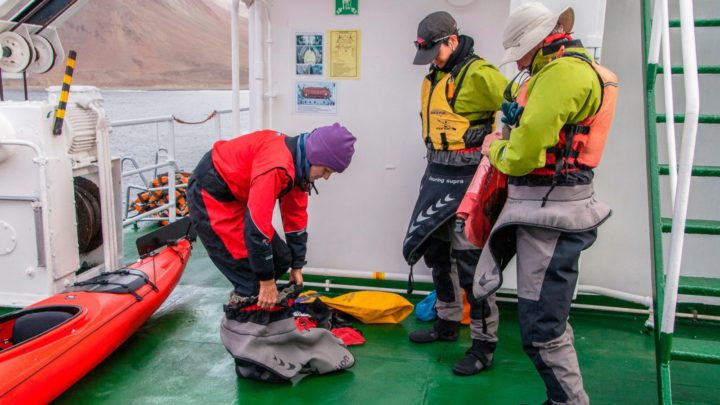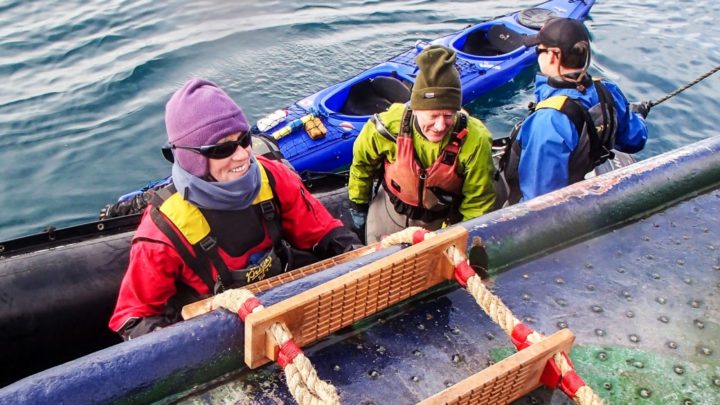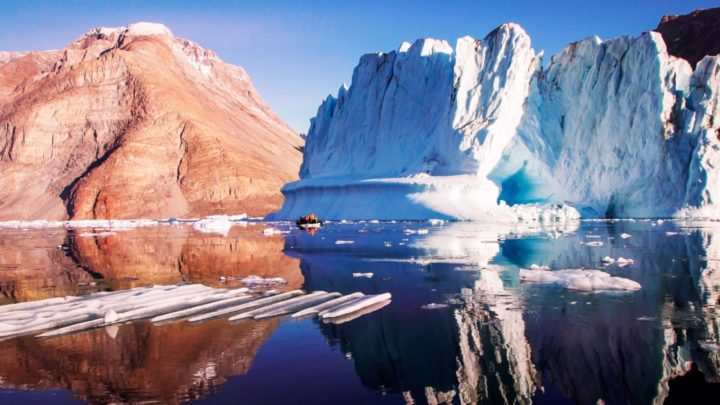‘I celebrated my 60th birthday by going up the Arctic with a paddle’

My 60th birthday loomed and I had no idea how to celebrate it. It seemed important to prove that being 60 didn’t mean I was old, so I looked for something adventurous to prove my point.
After researching many options and deciding against sailing around Cape Horn, I settled on a kayak trip in the Arctic. It was to commence in Iceland, then on to the remote eastern fjords of Greenland and finally to Svalbard (Spitzbergen), high in the arctic pack ice.
Before the trip, I worried incessantly about keeping up with younger and fitter cohorts, so I joined a local paddling group for weekly sessions in Tingalpa Creek and out into Moreton Bay (not quite the Arctic) in Queensland, Australia. Whilst the training would prove to be well worthwhile, I was unaware at that time that the young and super-fit were to be in the minority on the expedition. It would prove to be one of my greatest reliefs of the journey.
One week before my birthday I flew to Iceland to join the mother ship, The Polar Pioneer, a Finnish-built ice-strengthened research ship, which was to be home for the next two weeks. Accommodating only 54 persons, The Polar Pioneer is not a large ship, but it would prove very agile and able to navigate into the upper reaches of many Fjords. With my heart in my mouth, we embarked from Isafjordur and after a smooth overnight sail we arrived the next morning in ultra-remote Romer Fjord in south-east Greenland.

Before our first excursion, our leader, a jovial and fun-loving chocoholic named Judd, briefed us on the strict rules for paddling in this pristine and potentially dangerous environment. This included how close we could paddle to icebergs, the plan for evading polar bears and what to do if we met a walrus.
We put the walrus plan into action when one swam under our group off the island of Svalbard. Apparently, walrus have been known to attack kayaks — that wasn’t in the brochure!
Judd also taught us the technique for squeezing into our dry-suits, without which we would be unconscious in less than 15 minutes and freeze to death in a further 30 minutes, if we ended up in the freezing arctic water. It was a difficult procedure but by the end of the trip, most of us could at least get into them without help, although it was always an incredibly funny activity to watch.

Once in our dry-suits, we were free to climb into the kayaks. However, they were floating 2.5 metres below the deck of the ship and were only accessible by a rope ladder.
Over the edge we went one at a time, down the ladder and into an inflatable tender, from which we gingerly wiggled our way into our kayaks. Those of us who were novices imagined ourselves overbalancing and ending up in the chilly water. Did I mention how awkward it was to move around in the dry-suit, or that the wind was blowing quite strongly and the waves were standing up? But hey, 60 is still young — isn’t it?

Every expedition after was progressively more awe-inspiring as our confidence and competence improved. Our small group of paddlers quickly got into the routine of setting off once or twice a day to explore this amazing part of the world either in a kayak or a zodiac (large inflatable tender).
We looked up at huge icebergs from the level of the sea. These monsters came in a wide range of beautiful colours, from soft pinks to deep blues. Some were white and others had long dark brown streaks, which was soil collected when the ice was part of a glacier wending its way to the sea.

They were of all sizes and shapes, some stable and others unbalanced, trying hard to topple over. Some made strange noises as the trapped air inside them tried to escape. When they rolled over or calved (when pieces broke off them), a mini tsunami rippled out in all directions and we enjoyed a bumpy ride as we shared in these miracles of nature.
Our kayak expeditions averaged around 20 kilometres and usually the ever-ready Judd would find an interesting landing spot to share his stash of chocolate. If there was nowhere to stop, then rafting the kayaks together and floating was as good a way to relax and eat chocolate as any.
My fellow kayakers were an interesting group of men and women of all ages. All were friendly and helpful.
One fit young man, who was in the United States military, proved to be a particularly good paddle partner as he was quite happy to keep paddling whilst I slacked off in the front and took photos. Early in the trip I was sure to take my little waterproof camera, but I discovered that with care, I could use my good camera so long as I had a waterproof bag to keep it in.
As well as the ever-present icebergs, we paddled along a rock wall 1.6km high. The geologists in our group had a field day pointing out the different types of rock and explained how they were formed. Cameras clicked but couldn’t capture the majesty of the wall or the beautiful birds flying in and out of their nests high above the water.
On some paddles, we met up with the non-paddling passengers who had left the ship on zodiacs. These trips there were usually led by three expedition leaders who conducted different tours and shared their incredible knowledge of the arctic wilderness, pointing out the beautiful tiny flowers of the tundra, the musk ox camouflaged by standing totally still on the hillsides and the relics of previous Inuit civilisations lying on the ground in front of us.

At Renodde Bay we climbed to the top of a rocky outcrop to look down on a passage of deep green water which had been blocked by so many grounded icebergs that no more could pass through. Nicknamed Iceberg Alley, it proved a beautiful place to paddle through.

Back on the ship, we enjoyed lovely hot showers and nourishing meals prepared by our very friendly Russian crew. Ah yes, that was after climbing back up the rope ladder, passing the kayaks back onto the deck and wriggling out of our dry suits.
Was this trip suitably adventurous for my 60th birthday? It was perfect!
Without doubt it was the best holiday of my life and one I would do again at the drop of a hat. The expedition leaders and crew were professional and helpful, and the other passengers were friendly and ready to participate in all activities. The beautiful arctic scenery was breathtaking and never to be forgotten. Exploring it from the low vantage point and silence of a kayak is something I will never forget.








 Proudly Australian owned and operated
Proudly Australian owned and operated